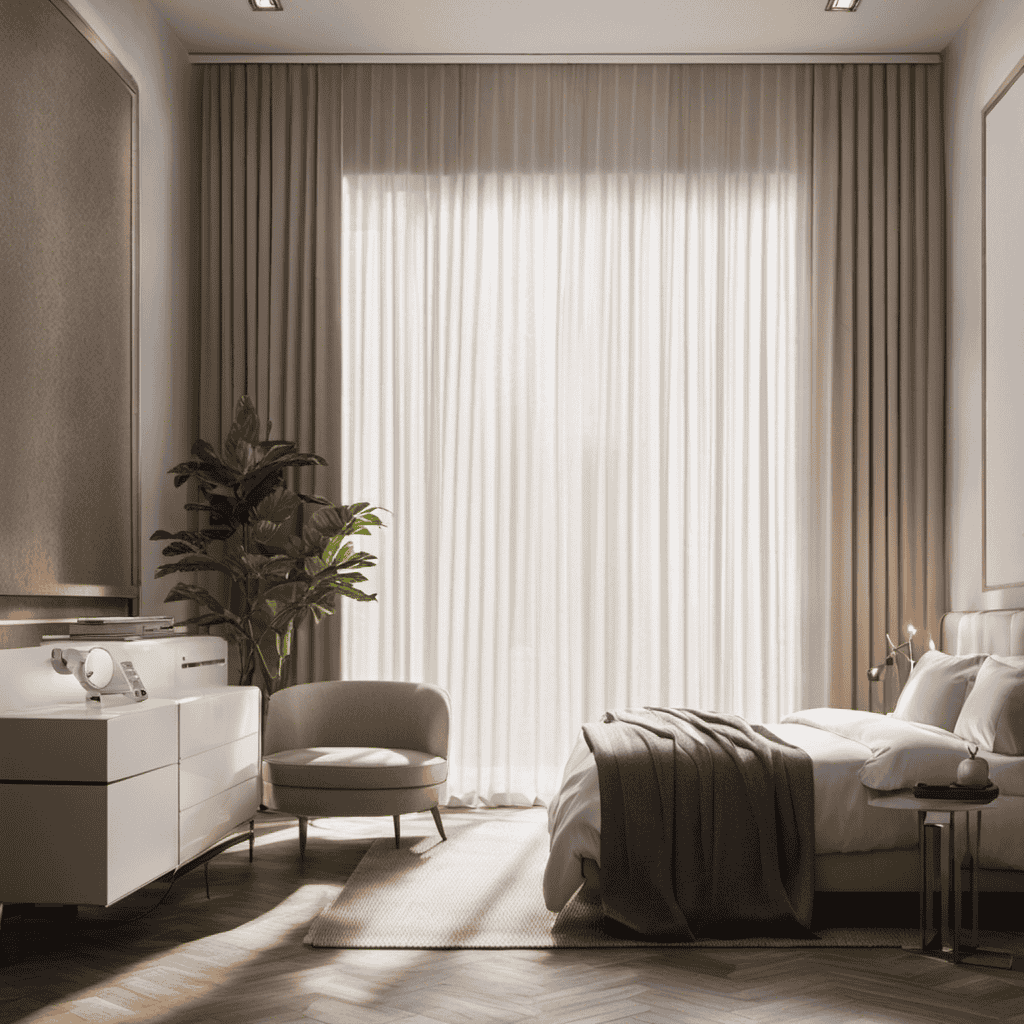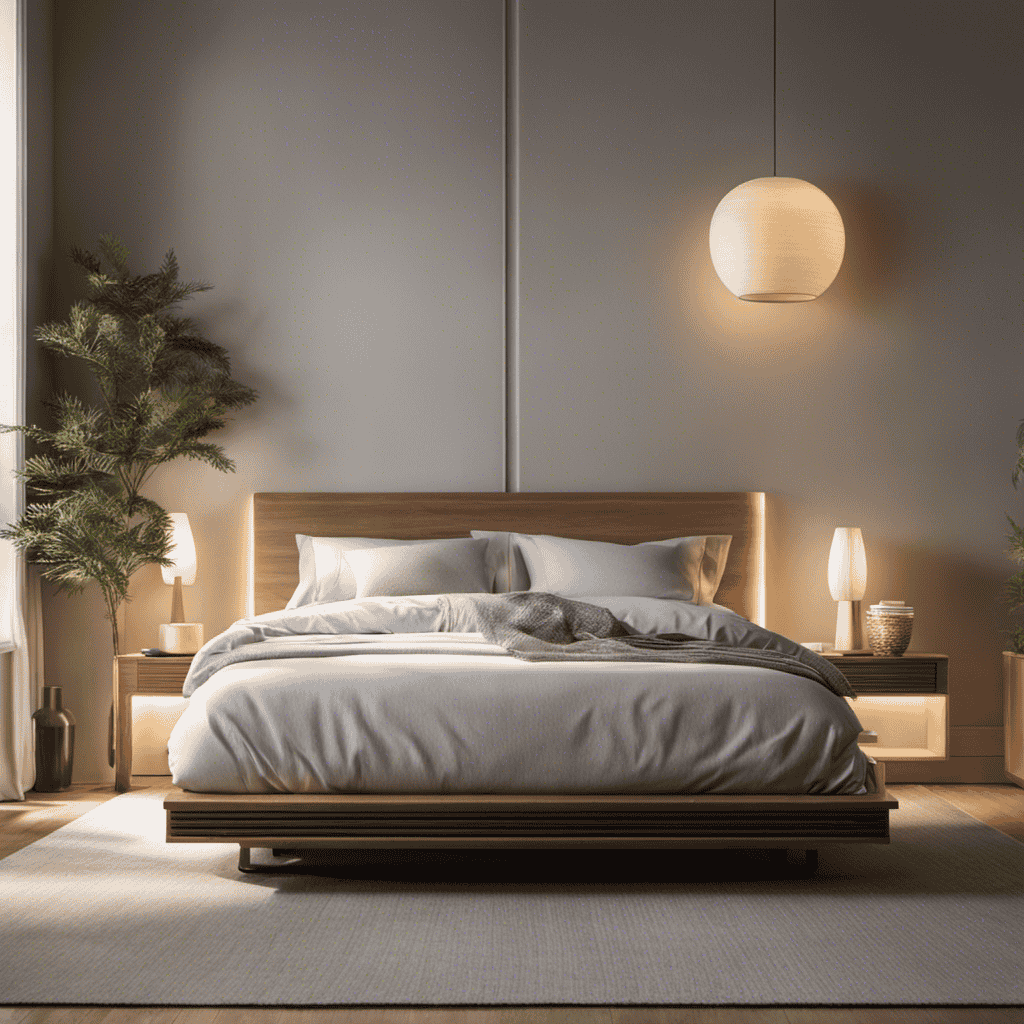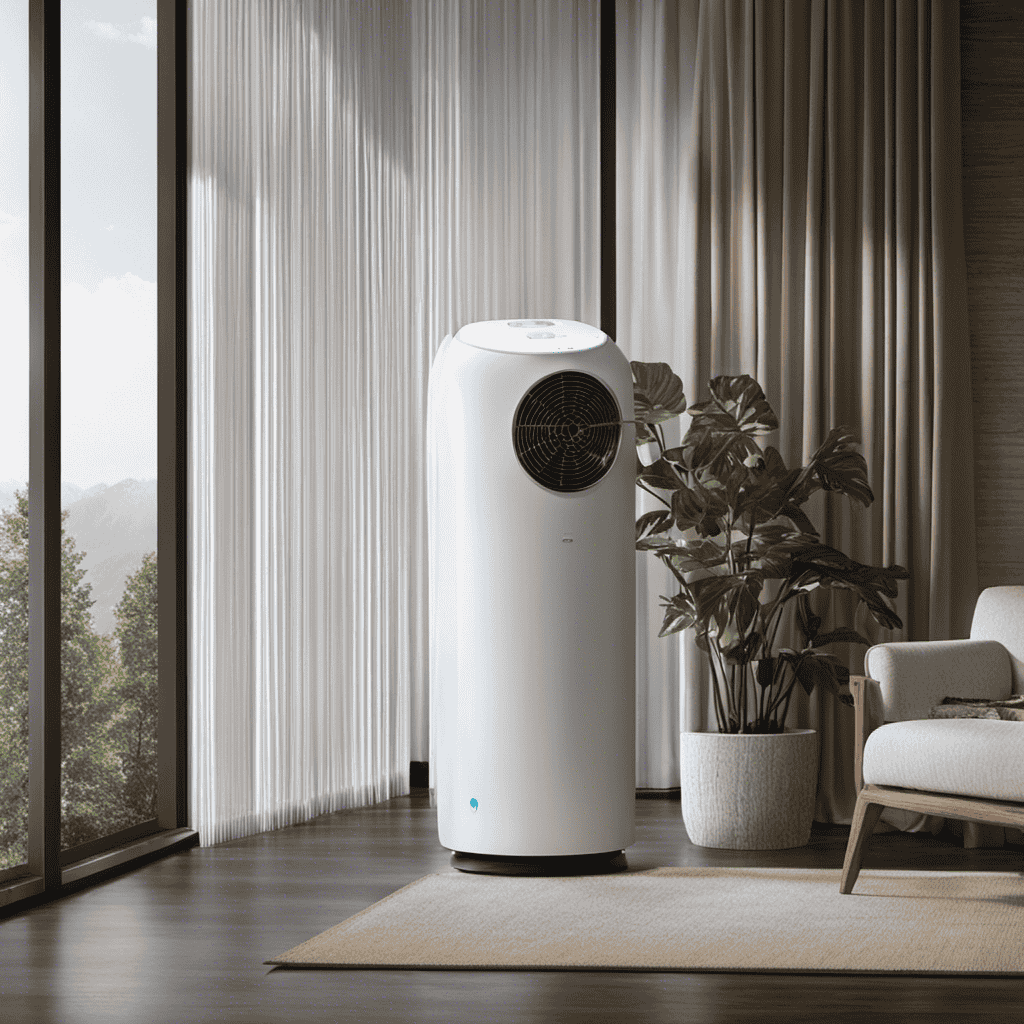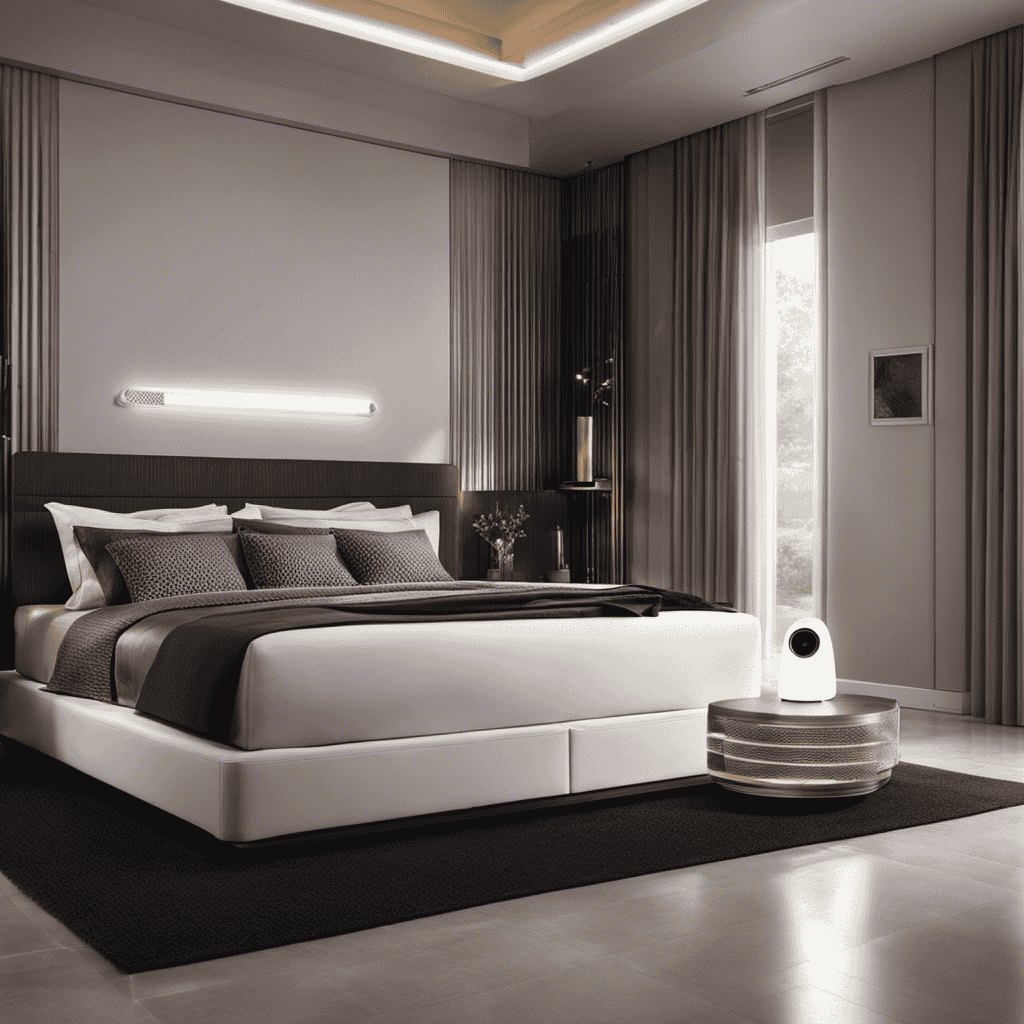Have you ever thought about the duration for which you should keep your air purifier running?
It’s like having a faithful companion by your side, diligently working to clean the air you breathe.
In this article, we will explore the factors that determine the runtime of an air purifier.
From the size of your room to the air quality conditions, we will uncover the optimal times to turn it on and off.
So, let’s dive in and discover how to maximize the benefits of this air-cleaning ally.
Key Takeaways
- The recommended duration for operating an air purifier depends on factors such as the size of the room, air quality of the environment, personal preferences and sensitivities, and maximizing impact on health.
- Room size plays a significant role in determining air purifier usage, as larger rooms may require a more powerful air purifier for efficient pollutant capture and filtration. Furniture and obstacles should also be considered to ensure proper air circulation and effectiveness.
- Air quality conditions greatly influence air purifier runtime, and adjusting settings based on poor air quality conditions can help maximize the purifier’s effectiveness. Factors such as the size of the room, level of air pollution, and the model of the purifier should be taken into account.
- Optimal times to turn on and off an air purifier include poor air quality conditions, peak pollution hours, cooking/cleaning activities, allergy seasons, and nighttime. Considering energy efficiency is also important when deciding usage times.
Factors to Consider When Determining Air Purifier Runtime
When determining air purifier runtime, there are several factors to consider.
One important factor is the recommended runtime provided by the manufacturer. This recommendation is based on the capacity and efficiency of the air purifier, ensuring that it operates optimally to clean the air.
Additionally, energy consumption is a critical consideration. Running an air purifier continuously can result in high energy usage, which may not be necessary for maintaining clean air. It is essential to balance the need for clean air with energy efficiency.
Some air purifiers come with built-in sensors that detect air quality and adjust the runtime accordingly, saving energy when air quality is optimal.
Recommended Duration for Operating an Air Purifier
The recommended duration for running an air purifier is typically a few hours each day. However, when determining the exact runtime, there are several factors to consider that can have an impact on the health benefits provided by the air purifier.
First and foremost, the size of the room or area being purified is crucial. Larger spaces may require longer runtime to ensure effective air cleaning.
Additionally, the air quality of the environment plays a role. If the air is heavily polluted or if there are specific allergens present, it may be necessary to run the air purifier for longer periods.
Lastly, personal preferences and sensitivities should be taken into account. Some individuals may benefit from extended runtime, while others may require less.
Ultimately, finding the right balance between runtime and air purification effectiveness is essential for maximizing the impact on health.
Understanding the Impact of Room Size on Air Purifier Usage
To effectively clean the air in your room, consider the impact of its size on the usage of an air purifier. The size of the room plays a crucial role in determining the effectiveness of an air purifier. Here are four key factors to keep in mind:
- Room volume: A larger room requires a more powerful air purifier to effectively clean the air.
- Air circulation: Proper air circulation is essential for an air purifier to capture and filter pollutants efficiently.
- Furniture and obstacles: The presence of furniture and other obstacles can obstruct the airflow and reduce the purifier’s effectiveness.
- Air purifier placement: Positioning the purifier in a central location allows for better air circulation and coverage.
Understanding these factors will help you optimize the usage of your air purifier by adjusting its settings and ensuring proper placement.
Now let’s explore how air quality conditions influence air purifier runtime.
How Air Quality Conditions Influence Air Purifier Runtime
If air quality conditions are poor, adjusting the settings of your purifier can maximize its runtime. The effectiveness of an air purifier is influenced by various factors, including the size of the room, the level of air pollution, and the specific model of the purifier. To understand how air quality conditions impact air purifier runtime, it is essential to consider the air purifier’s energy consumption. The table below provides an overview of the influences on air purifier effectiveness, runtime, and energy consumption.
| Factors Influencing Air Purifier | Effectiveness | Runtime | Energy Consumption |
|---|---|---|---|
| Size of the room | Larger rooms | Longer | Higher |
| Level of air pollution | Higher levels | Longer | Higher |
| Model of the purifier | Higher quality | Longer | Varies |
Optimal Times to Turn On and Off an Air Purifier
Optimal times for turning on and off an air purifier depend on factors such as air quality conditions and personal preferences. It is recommended to turn on the air purifier when indoors and air quality is poor, such as during high pollen or smog days.
Additionally, it is important to consider energy efficiency when deciding when to use your air purifier. Here are some recommended times to turn on and off your air purifier:
-
During the night: Turn on the air purifier before going to bed to ensure clean air while you sleep.
-
During peak pollution hours: Turn on the air purifier when pollution levels are highest, usually during the early morning and late afternoon.
-
During cooking or cleaning: Turn on the air purifier while cooking or cleaning to remove airborne particles or odors.
-
During allergy seasons: Turn on the air purifier when allergens such as pollen are at their peak.
Adjusting Air Purifier Runtime Based on Allergies and Sensitivities
Consider adjusting the runtime of your air purifier based on your allergies and sensitivities to ensure maximum relief.
By adjusting the filter settings and monitoring air quality, you can optimize the performance of your air purifier.
Allergies and sensitivities vary from person to person, so it’s important to customize the runtime to meet your specific needs.
If you suffer from severe allergies, you may want to run the air purifier continuously or for longer periods of time, especially during peak allergy seasons.
On the other hand, if your allergies are mild or if you’re sensitive to noise or energy consumption, you may choose to run the air purifier for shorter intervals or only when needed.
Regularly monitoring air quality can help you determine when it’s necessary to adjust the runtime of your air purifier.
Extending the Lifespan of Your Air Purifier Through Proper Usage
In order to maximize the lifespan of your air purifier and ensure its optimal performance, it is crucial to consider the duration of usage, as well as regular cleaning and maintenance.
Research suggests that running the air purifier continuously for extended periods may not be necessary, as the effectiveness of air purification tends to plateau after a certain point.
Additionally, regular cleaning and maintenance, such as replacing filters and cleaning the unit itself, are essential to keep the air purifier functioning efficiently and to prevent the accumulation of dust and pollutants.
Optimal Usage Duration
You should leave the air purifier on for at least 2 hours to ensure it effectively cleans the air in your space. This recommended runtime allows the purifier to cycle through multiple air exchanges, capturing and removing pollutants.
Here are some key points to consider:
- The air purifier continuously draws in air, trapping particles in its filters.
- Over time, the purifier’s filters become more efficient as they capture and retain pollutants.
- Running the purifier for longer periods minimizes the chance of airborne contaminants re-entering your space.
- It’s important to balance the recommended runtime with energy consumption to optimize efficiency.
Cleaning and Maintenance
Regular cleaning and maintenance of the filters is essential for optimal performance of the air purifier. To ensure that the air purifier effectively removes common air pollutants, such as dust, pollen, pet dander, and smoke particles, it is important to follow proper cleaning techniques.
Here is a table outlining recommended cleaning techniques for different types of filters:
| Filter Type | Cleaning Technique |
|---|---|
| HEPA Filter | Vacuum or wash |
| Carbon Filter | Replace |
| Pre-filter | Vacuum or wash |
For HEPA filters, vacuuming or washing is recommended to remove accumulated particles. Carbon filters, on the other hand, should be replaced periodically as they lose their effectiveness over time. Pre-filters can be vacuumed or washed to remove larger particles before they reach the main filters.
Frequently Asked Questions
Can Leaving an Air Purifier on for Too Long Have Negative Effects on Air Quality or Health?
Leaving an air purifier on for extended periods can have potential risks on air quality and health. Prolonged use may lead to decreased indoor humidity levels, increased ozone levels, and noise pollution, which can negatively impact respiratory health and sleep quality.
Should I Turn off My Air Purifier When I Leave the House?
I leave my air purifier on all day. It is safe to leave it unattended as long as it is properly maintained and there are no safety hazards present.
Can Leaving an Air Purifier on Overnight Be Harmful?
Leaving an air purifier on overnight can have potential risks, such as the effects of long-term exposure to air purifiers and the potential risks of using them in bedrooms.
How Often Should I Clean or Replace the Filters in My Air Purifier?
Cleaning frequency and filter replacement are important maintenance tasks for an air purifier. Regular cleaning and filter replacement ensure optimal performance and efficiency. Neglecting these tasks can lead to reduced air quality and decreased effectiveness.
Is It Necessary to Adjust the Runtime of the Air Purifier Based on the Season or Weather Conditions?
Adjusting air purifier runtime based on season or weather is necessary. The amount of time to leave the purifier on varies during different seasons. It is important to consider factors such as pollen levels, humidity, and indoor air quality.
Conclusion
In conclusion, understanding the factors that influence air purifier runtime is crucial for achieving optimal air quality.
Research has shown that the recommended duration for operating an air purifier is around 8-12 hours per day. However, it is important to consider room size, air quality conditions, allergies, and sensitivities when determining runtime.
Interestingly, studies have revealed that running an air purifier for longer periods can significantly reduce the number of airborne particles, with a reduction of up to 99.9% observed after 24 hours of continuous use. This statistic emphasizes the effectiveness of extended air purifier usage in improving indoor air quality.
By following proper usage guidelines, we can extend the lifespan of our air purifiers and ensure a healthier living environment.










